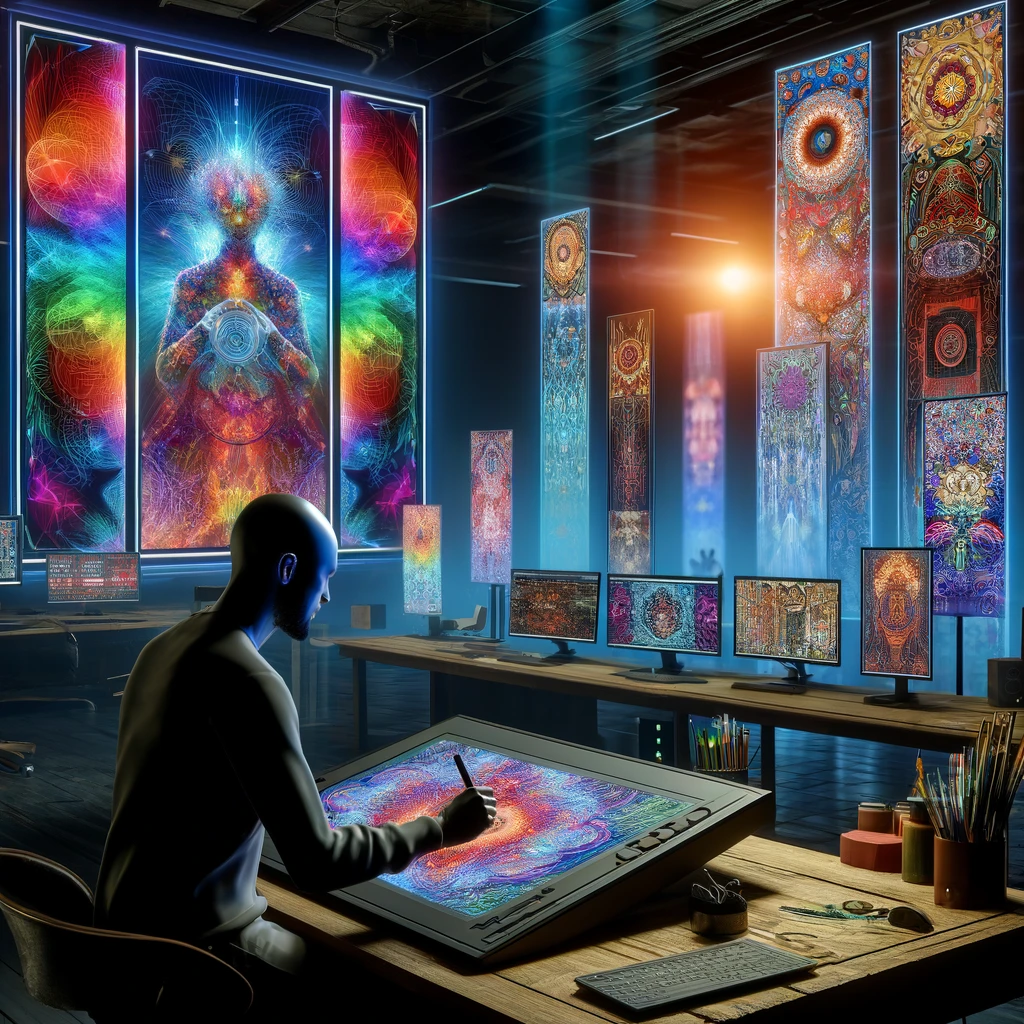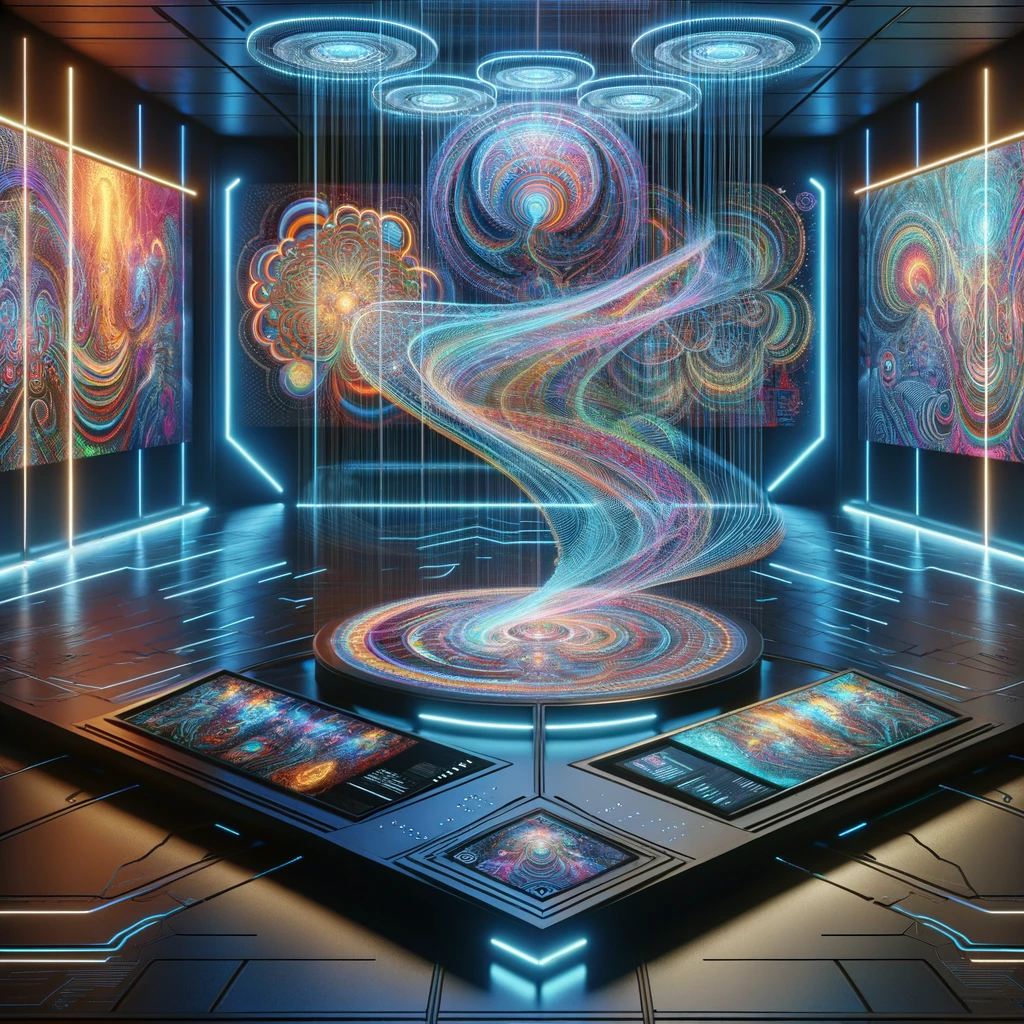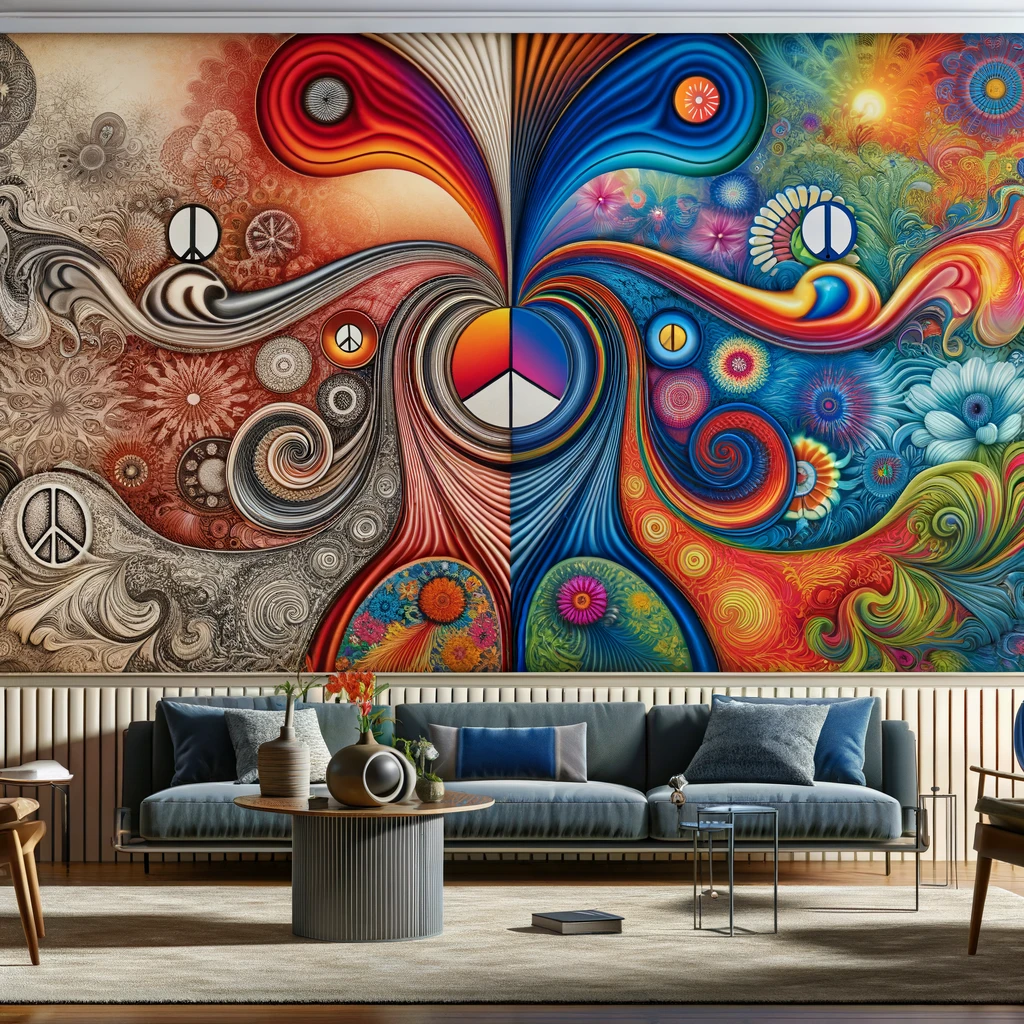
The Evolution of Psychedelic Art
Origins of Psychedelic Art
Historical Context
The 1960s represented a period of profound social and cultural upheaval. Psychedelic art emerged as a visual counterpart to the decade’s radical movements, embodying the spirit of liberation and the widespread use of psychedelic drugs like LSD. The art form became a tool for expressing the expanding consciousness and rebellion against the strict societal norms of the previous era.
Key Characteristics
Psychedelic art is immediately recognizable by its vivid palette and surreal visuals. Key features include:
- Bright, Saturated Colors: Employing an array of luminous hues that often clash in conventional aesthetic terms to evoke sensory overload.
- Fluid Forms: Imagery often melts and flows, with no fixed boundaries, reflecting the fluidity of psychedelic experiences.
- Kaleidoscopic Patterns: Repeating motifs and mandala-like patterns intended to represent altered states of consciousness.
- Textual Interplay: Use of distorted or elaborately styled text that merges with the overall imagery, often making the text a central element of the artwork.
Prominent Artists
Artists who were pivotal to the development of psychedelic art include:
- Peter Max: Known for his poster art that featured vivid, transcendental motifs and became emblematic of the psychedelic movement.
- Victor Moscoso: His work is notable for its intense colors and dynamic compositions, which utilized visual contrasts and optical illusions to simulate the psychedelic experience.
Psychedelic Art in the 1970s and 80s
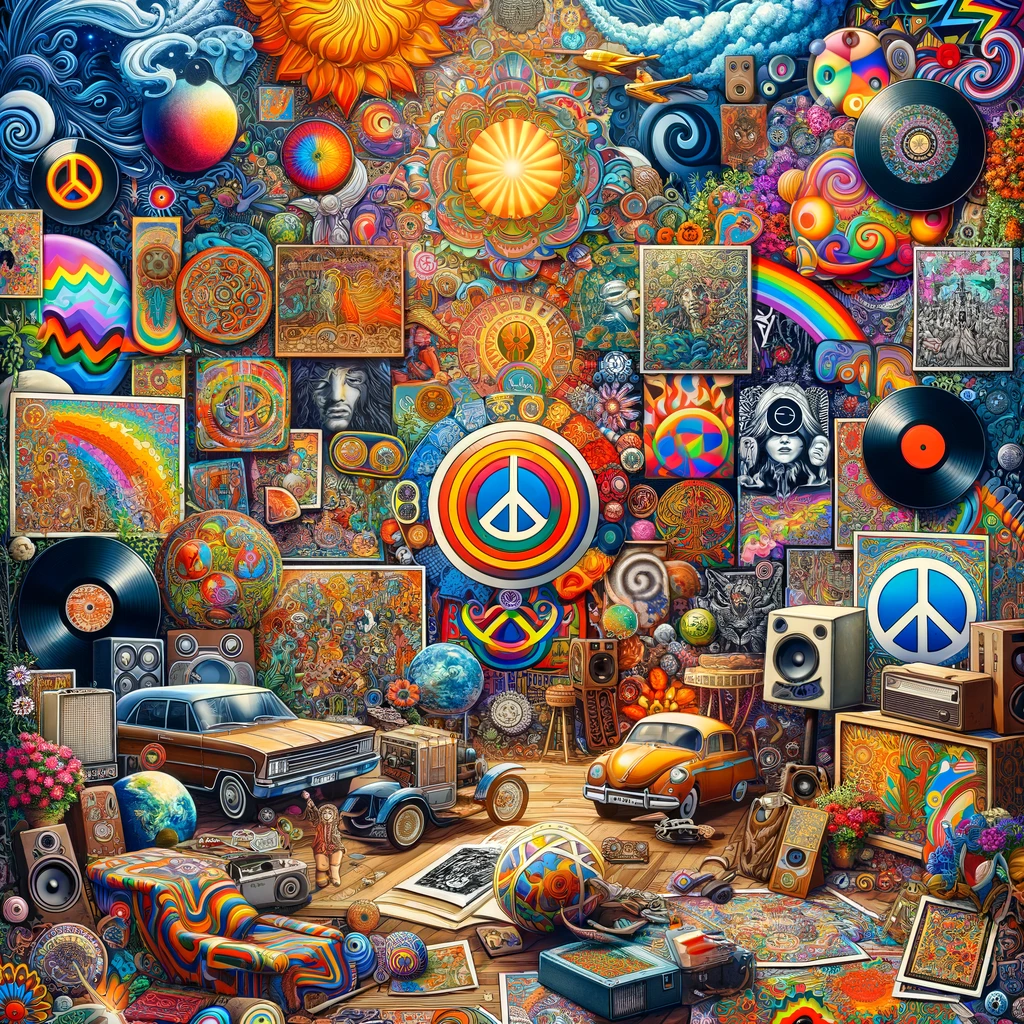
Evolution of Style
During the 1970s and 1980s, psychedelic art evolved in response to technological advancements and the changing social climate. While the initial fervor of the 1960s waned, the art form found new expressions and mediums.
Integration with New Media and Technology
- Album Covers: Music continued to be a significant medium for psychedelic expression. Album covers for rock and progressive bands often featured psychedelic themes, serving as both marketing tools and essential aspects of the artist’s creative expression.
- Concert Posters: Live music performances were central to psychedelic culture, with posters becoming collectible artworks.
Continued Influence in Graphic Design
- Advertising: Elements of psychedelic art were co-opted by mainstream advertising, utilizing vibrant colors and whimsical designs to capture the attention of a broader audience.
- Animation: Advances in animation technology allowed for more complex and visually engaging representations of psychedelic imagery.
Key Artists and Artworks
The period saw several artists refining and expanding the boundaries of psychedelic art:
- Mati Klarwein: Known for his albums covers for Miles Davis and Santana, Klarwein’s work is characterized by its mystical and exotic imagery that blends different cultural elements in a psychedelic context.
- Storm Thorgerson: As part of the graphic art group Hipgnosis, Thorgerson designed some of the most iconic album covers in modern music, utilizing surreal and psychedelic imagery to create visually stunning pieces.
These sections highlight the significant historical, cultural, and artistic developments within the realm of psychedelic art, showing its transition from a form of countercultural expression to a recognized and influential style in visual arts and beyond.
Explore the vibrant world of psychedelic art and bring its mesmerizing energy into your space with our collection of trippy wall art. Shop now and elevate your decor!
Revival and Transformation in the 90s and Early 2000s
Resurgence of Interest
The 1990s witnessed a renewed interest in psychedelic art, primarily driven by the emerging rave culture and the expansion of electronic music scenes. This period marked a revival where both old and new elements of psychedelia were blended to create vibrant visual experiences.
Influence of Rave Culture
- Event Flyers and Posters: These became essential mediums for psychedelic expression, utilizing neon colors and fluid, surreal designs to evoke the energy of rave parties.
- Fashion: Clothing and accessories featured bold, psychedelic patterns and were seen as extensions of the individual’s identity within the rave scene.
Technological Advances
Advancements in digital technology during the 1990s transformed how artists created and distributed psychedelic art.
Digital Art and Software
- Graphic Design Software: Tools like Adobe Photoshop and Illustrator allowed artists to manipulate images in unprecedented ways, creating more complex and layered psychedelic visuals.
- Animation and Video: Enhanced capabilities in digital animation led to the integration of psychedelic imagery in music videos and experimental films, further popularizing the aesthetic.
Modern Psychedelic Art and Wall Decor
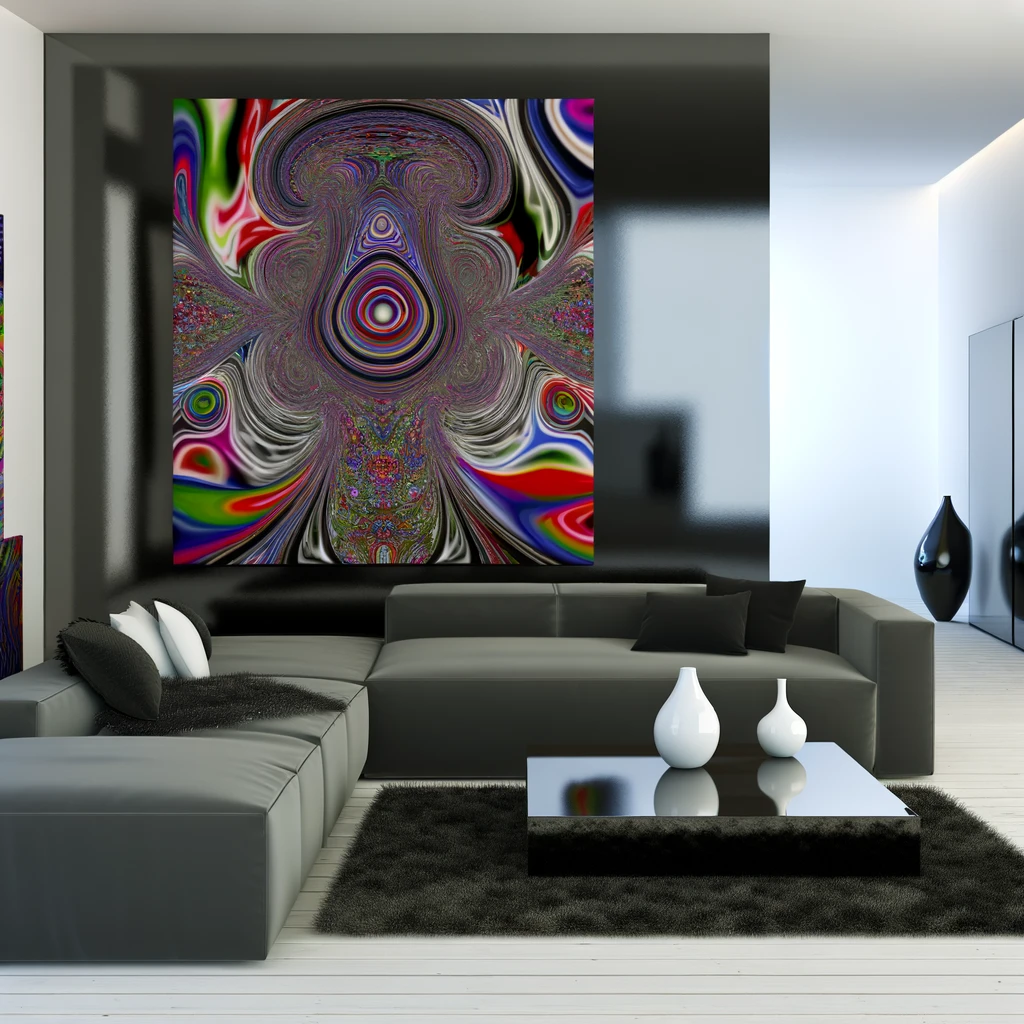
Contemporary Applications in Home Decor
Today, psychedelic art is not just a relic of the past but a thriving influence in interior design, often used to create dynamic and engaging environments.
Wall Decor
- Wallpapers and Murals: Large-scale prints of classic and modern psychedelic designs are used to make bold statements in living spaces.
- Art Prints: Limited edition prints are popular among collectors and enthusiasts looking to add a touch of psychedelia to their home aesthetics.
Popular Themes and Styles
The themes and styles of modern psychedelic art in wall decor often involve a mix of abstract forms, vibrant colors, and mystical elements, reflecting both traditional influences and contemporary innovations.
Abstract and Cosmic Imagery
- Space and Cosmos: Many modern pieces incorporate elements of space and cosmic imagery, tying in themes of exploration and the unknown, which are central to the psychedelic experience.
- Nature and Wildlife: Incorporating earthy elements and wildlife in surreal, vibrant compositions continues to be a staple in psychedelic themes.
Tips for Choosing Psychedelic Art for Modern Interiors
Selecting the right piece of psychedelic art for a space requires consideration of several factors to ensure it complements the overall decor.
Color Matching
- Vibrant vs. Subdued: Depending on the room’s existing color scheme, a vibrant piece might energize the space, whereas a more subdued artwork could serve as a sophisticated focal point.
Theme Cohesion
- Matching Themes: Aligning the artwork’s theme with the room’s purpose (e.g., calming psychedelic landscapes for bedrooms) can enhance the environmental aesthetics and the psychological impact of the space.
These sections of the blog post delve deep into the transition of psychedelic art through the ’90s and its profound integration into modern home decor, highlighting its enduring relevance and appeal in contemporary culture.
Technological Influence on Modern Psychedelic Art
Digital Tools and Techniques
The advent of digital technology has revolutionized the creation and dissemination of psychedelic art, allowing artists to explore new frontiers of creativity and expression.
Software and Applications
- Adobe Suite: Programs like Photoshop and Illustrator provide artists with versatile tools for manipulating images, creating intricate patterns, and experimenting with colors.
- Procreate: This digital drawing and painting app has gained popularity among artists for its intuitive interface and extensive brush library, making it ideal for creating psychedelic visuals on tablets and mobile devices.
Emerging Trends in AI-generated Art
As artificial intelligence continues to advance, it has begun to influence the world of psychedelic art in novel ways.
Generative Art
- Algorithmic Creations: Artists and developers are utilizing machine learning algorithms to generate psychedelic imagery autonomously, producing mesmerizing patterns and fractal designs.
- Interactive Installations: AI-powered installations allow viewers to interact with and even manipulate psychedelic visuals in real-time, creating immersive experiences.
Cultural and Psychological Impact
Psychological Effects of Psychedelic Art
The intricate and visually stimulating nature of psychedelic art can have profound effects on the viewer’s psyche.
Calming and Therapeutic Properties
- Stress Reduction: Studies have shown that viewing psychedelic imagery can induce a state of relaxation and reduce stress levels, making it a popular choice for creating tranquil environments in homes and wellness spaces.
- Mindfulness and Meditation: The intricate patterns and surreal landscapes found in psychedelic art can facilitate mindfulness practices and aid in meditation, promoting mental clarity and focus.
Therapeutic Applications
In addition to its aesthetic appeal, psychedelic art is increasingly being recognized for its therapeutic potential.
Psychedelic-Assisted Therapy
- Integration in Healing Practices: Some therapists incorporate psychedelic-inspired visuals into therapy sessions to enhance emotional processing and facilitate introspection.
- Support for Mental Health: Patients suffering from anxiety, depression, or PTSD may benefit from exposure to psychedelic art as part of their treatment regimen, helping to alleviate symptoms and promote psychological well-being.
These sections highlight the profound impact of technology on the creation and dissemination of psychedelic art, as well as the therapeutic potential and psychological effects of engaging with such artwork.
Experience the captivating allure of psychedelic art firsthand by exploring our collection of trippy wall art. Transform your space into a mesmerizing sanctuary of creativity and imagination. Shop now to ignite your inspiration!
Case Studies
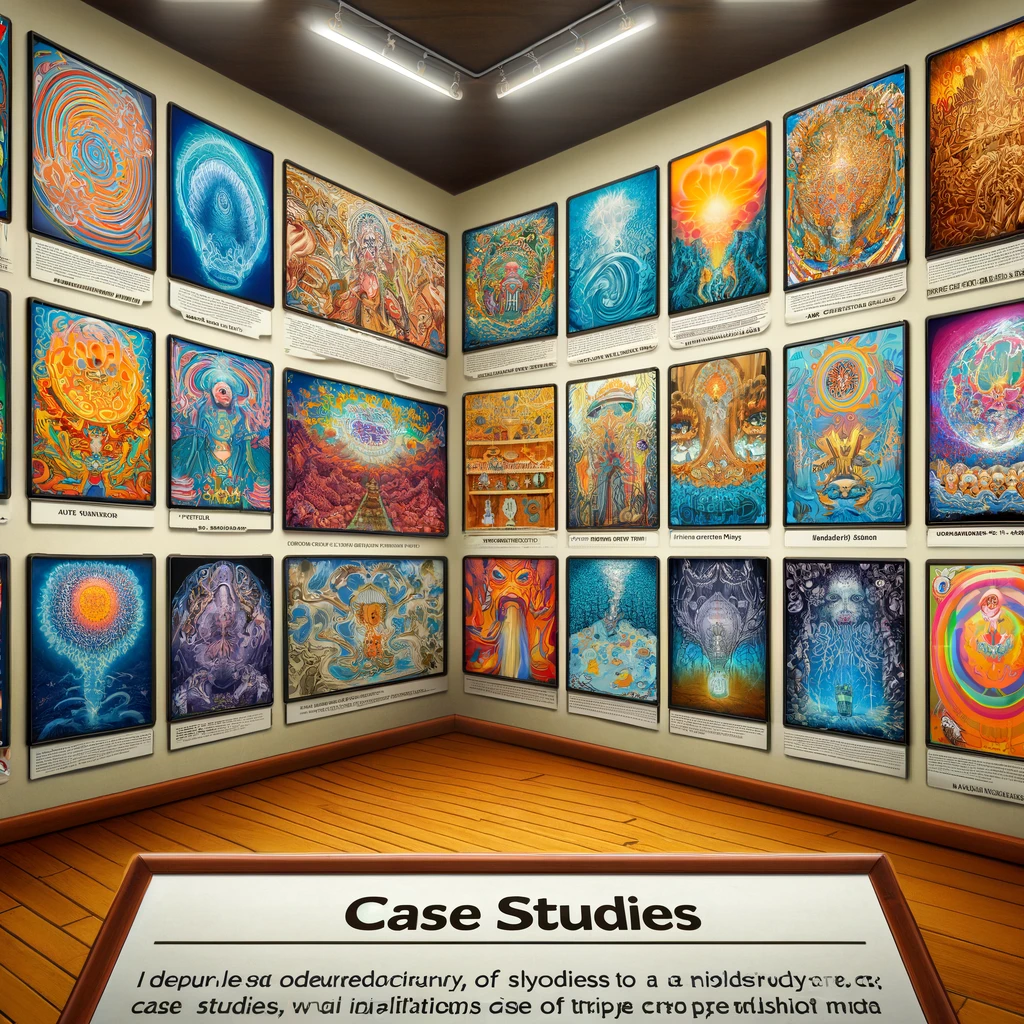
Home Interiors
Examining how psychedelic art is integrated into residential spaces provides insight into its practical application in interior design.
Feature Walls and Statement Pieces
- Large-scale Murals: In living rooms or bedrooms, a single psychedelic mural can serve as a captivating focal point, anchoring the room’s design scheme and infusing it with vibrant energy.
- Gallery Walls: Grouping together smaller psychedelic prints or artworks creates a dynamic display that adds visual interest to otherwise plain walls.
Professional Spaces
The incorporation of psychedelic art in professional settings showcases its versatility and ability to enhance creativity and productivity.
Office Environments
- Creative Studios: Psychedelic art in workspaces can inspire creativity and innovation, providing employees with a visually stimulating environment that fosters out-of-the-box thinking.
- Wellness Centers: In spaces dedicated to wellness and mental health, psychedelic-inspired visuals can promote relaxation and mindfulness, creating a calming atmosphere for clients and practitioners alike.
Future of Psychedelic Art
Predictions and Emerging Trendsc
The future of psychedelic art holds promise for further innovation and exploration, driven by advancements in technology and shifts in cultural perspectives.
Integration of Virtual Reality (VR) and Augmented Reality (AR)
- Immersive Experiences: Expect to see more immersive psychedelic art experiences in virtual reality environments, allowing viewers to interact with and explore surreal landscapes in unprecedented ways.
- Augmented Reality Installations: AR technology will likely enable users to overlay psychedelic visuals onto their physical surroundings, blurring the lines between digital and physical art forms and creating unique interactive experiences.
Upcoming Trends
Staying abreast of emerging trends can provide valuable insights into where psychedelic art is headed in the coming years.
Hybrid Art Forms
- Mixed Media: Artists may continue to experiment with combining traditional techniques with digital processes, resulting in hybrid artworks that push the boundaries of psychedelic expression.
- Interactive Installations: Anticipate an increase in interactive psychedelic art installations that invite viewer participation and engagement, offering memorable experiences that transcend traditional gallery settings.
Collaborations and Cross-Disciplinary Work
Look out for collaborations between psychedelic artists and other creative professionals, such as musicians, filmmakers, and technologists. These partnerships will likely lead to innovative projects that merge psychedelic aesthetics with other artistic mediums, further expanding the boundaries of the art form.
Cultural Impact
As psychedelic art continues to evolve, its impact on culture and society will also grow, influencing not only the visual arts but also music, fashion, and beyond. Expect to see psychedelic aesthetics permeate various aspects of popular culture, reflecting changing attitudes and values.
Summary of Evolution and Enduring Appeal
In conclusion, the journey of psychedelic art from its origins in the 1960s to its integration into modern wall decor has been one of continual evolution and adaptation. What began as a form of countercultural expression has now become a mainstream aesthetic choice, reflecting the enduring appeal of its vivid colors, surreal imagery, and psychedelic themes.
Encouragement for Exploration
As we reflect on the rich history and cultural significance of psychedelic art, it’s clear that its influence extends far beyond the confines of the art world. Whether as a means of personal expression, a tool for interior design, or a catalyst for creative inspiration, psychedelic art continues to captivate and inspire audiences of all ages.
FAQ Section
Where to Find Authentic Psychedelic Art?
Authentic psychedelic art can be found through various channels, including art galleries, online marketplaces, and directly from the artists themselves. Look for reputable sources and consider supporting independent artists to ensure the authenticity and quality of your purchase.
Tips for Integrating Psychedelic Art in Minimalist Decor?
When incorporating psychedelic art into minimalist decor, consider opting for pieces with subtle or monochromatic color schemes that complement the clean lines and simplicity of minimalist design. Choose artworks that add visual interest without overwhelming the space, and aim for a harmonious balance between the artwork and its surroundings.
Can Psychedelic Art Enhance Productivity in a Workspace?
While the effects of psychedelic art on productivity may vary from person to person, studies have shown that exposure to visually stimulating environments can boost creativity and cognitive function. Incorporating psychedelic-inspired visuals into a workspace may help stimulate ideas and foster a more dynamic and engaging work environment.
These sections provide a concise summary of the evolution and significance of psychedelic art, along with practical tips and insights to guide readers in exploring and incorporating this vibrant aesthetic into their lives.
